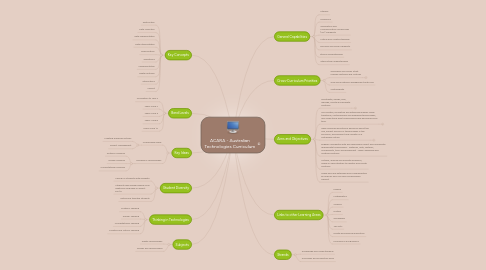ACARA - Australian Technologies Curriculum
by Chandler Sanford


1. Band Levels
1.1. Foundation to Year 2
1.2. Years 3 and 4
1.3. Years 5 and 6
1.4. Years 7 and 8
1.5. Years 9 and 10
2. Student Diversity
2.1. Caring for students with disability
2.2. Students who speak English as an additional language or dialect EAL/D
2.3. Gifted and talented students
3. General Capabilities
3.1. Literacy
3.2. Numeracy
3.3. Information and Communication Technology (ICT) capability
3.4. Critical and creative thinking
3.5. Personal and social capability
3.6. Ethical understanding
3.7. Intercultural understanding
4. Key Concepts
4.1. Abstraction
4.2. Data collection
4.3. Data representation
4.4. Data interpretation
4.5. Specification
4.6. Algorithms
4.7. Implementation
4.8. Digital systems
4.9. Interactions
4.10. Impact
5. Key Ideas
5.1. Overarching Ideas
5.1.1. Creating preferred futures
5.1.2. Project Management
5.2. Thinking in Technologies
5.2.1. Systems Thinking
5.2.2. Design Thinking
5.2.3. Computational Thinking
6. Cross-Curriculum Priorities
6.1. Aboriginal and Torres Strait Islander histories and cultures
6.1.1. Materials
6.1.2. Personel
6.1.3. Services
6.1.4. Duration
6.2. Asia and Australia's engagement with Asia
6.3. Sustainability
7. Aims and Objectives
7.1. Investigate, design, plan, manage, create and evaluate solutions.
7.1.1. Dependencies
7.1.2. Milestones
7.2. Are creative, innovative and enterprising when using traditional, contemporary and emerging technologies, and understand how technologies have developed over time.
7.2.1. Schedule
7.2.2. Budget
7.3. Make informed and ethical decisions about the role, impact and use of technologies in the economy, environment and society for a sustainable future.
7.3.1. KPI's
